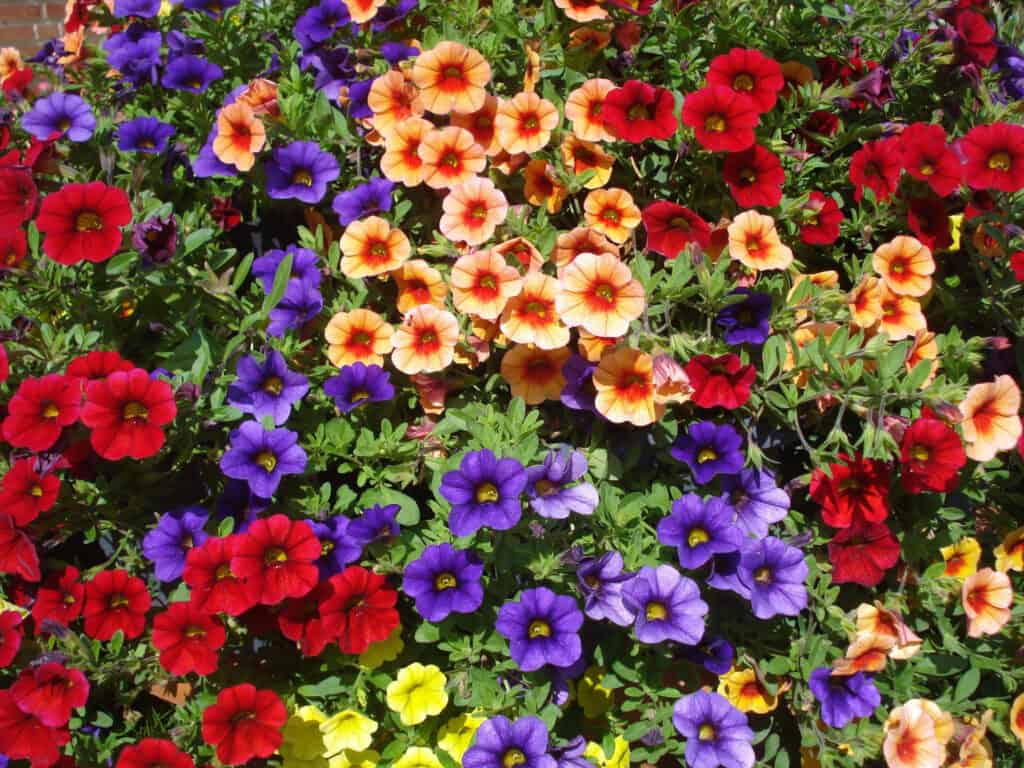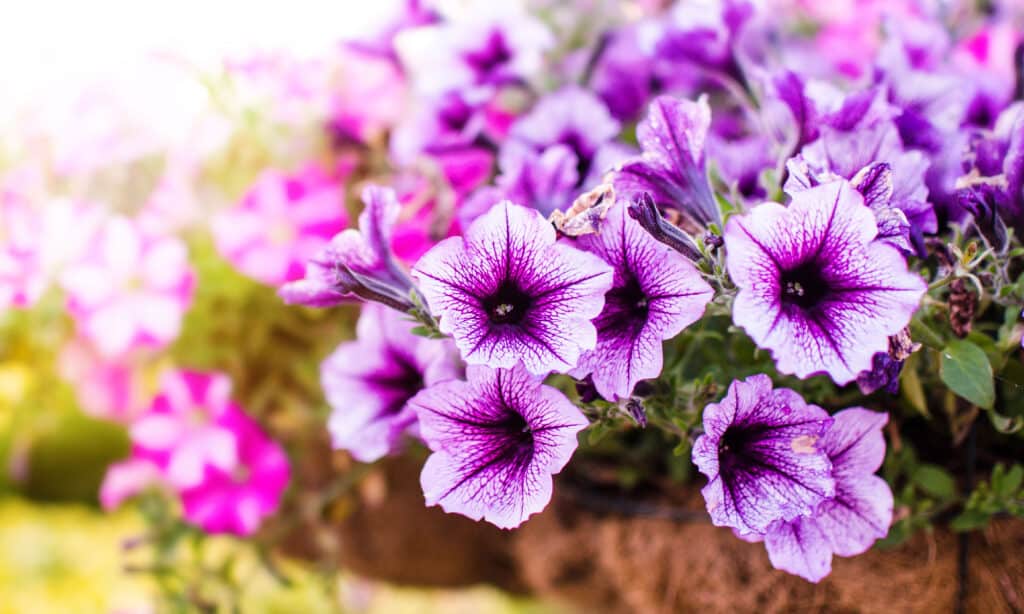Are you looking for a blazing hit of color for your flower borders? Look no further than calibrachoas and petunias. Both of these plants are easy to grow and provide summer-long color, but there are a few differences you need to know in order to make the most of them. Here are the differences between calibrachoa vs. petunia.
What Are the Main Differences Between Calibrachoa vs. Petunia?

adina munteanu/Shutterstock.com
The main differences between calibrachoa vs petunia are their flower size, scent, and the stickiness of their foliage. Petunias have larger flowers, a sweet scent, and sticky leaves. Calibrachoas are very similar, but their foliage is non-sticky, their flowers are smaller (but just as vivid), and they have a much milder scent.
Are Calibrachoa vs. Petunia Different?

iStock.com/Liliboas
Petunias are a genus in the Solanaceae family, alongside tobacco, tomatoes, and potatoes. There are around 20 different species of petunia and they’re very popular bedding plants. The common garden petunia’s scientific name is Petunia × atkinsiana.
Calibrachoas are also in the Solanaceae family and were originally classified in the petunia genus, but after a few hundred years of debate they were finally given their own genus in 1985. There are 28 different kinds of wild calibrachoa and they look very similar to petunia. In fact, some botanists still argue they are petunias!
Calibrachoas are commonly known as Million Bells, which is the name of the most popular cultivar, but petunias don’t have a common name.
What Are Petchoas?
It’s worth mentioning petchoas here. Petochoas are a hybrid of petunia and calibrachoa as you can see from the name. “Pet” (petunia) and “choa” (calibrachoa)!
History of Calibrachoa vs. Petunia

iStock.com/Mark R Coons
Petunias get the name from the Tupi-Guarani word “petun” for tobacco. They’re native to South America where the Inca and Mayan believed they could ward off evil spirits with their sweet scent. They also drank tea made from their flower buds.
When European explorers found petunias in the early 1800s, they took them back to Europe where plant breeders began crossing them to create showier blooms. In Victorian Britain’s language of flowers, petunias confusingly meant both easy companionship and simmering resentment!
Calibrachoas were considered petunias, and because they are found in the same native range, they have the same history as petunias. However, when botanists realized they were not the same plant, the genus calibrachoa was created and named after the Mexican botanist Antonio de la Cal y Bracho who passed in 1833.
If you’re struggling to pronounce calibrachoa, it’s ka-li-bra-KO-ah.
Calibrachoa and Petunia Growing Zones
Petunias are not frost-hardy, so they’re annuals in most areas, which means they germinate, flower, and die all in one season. However, they are tropical plants from South America so in zones 9-11 petunias are tender perennials.
Perennial means they will grow back the following year, although in tropical climates they will flower all year round.
And calibrachoa? The same! They are not frost-hardy either and only grow as perennials in zones 9-11.
Calibrachoa vs. Petunia: Foliage

Maya Afzaal/Shutterstock.com
Petunias have trailing or branching foliage that will happily mound up or hang from a basket. Their leaves are ovate and mid to bright green depending on the cultivar and they can reach an inch in length and spread.
Nearly all petunias have hairy foliage that’s sticky. Some botanists believe this deters pests like aphids that get trapped in the sticky liquid, but others think it’s so the vines can stick together and avoid breaking under their weight.
Petunia stems and foliage will grow to 24 inches tall and 36 inches in spread all in the space of one growing season, so they need plenty of fertilizer and water.
Calibrachoas spread, hang, and mound like petunias and have the same shade of foliage, but the individual leaves are much thinner. Calibrachoa leaves are only one-half an inch wide.
Petunia vs. Calibrachoa: Flowers
Petunias have five petalled trumpet-shaped flowers in every color imaginable. There are even striped, speckled, and mottled versions in black, white, purple, yellow, pink, and red.
In contrast, calibrachoa flowers have five petals but they are smaller. Some people call them mini petunias!
Both plants are vigorous growers that fill hanging baskets, containers, and flower borders with rainbow colors.
Are Calibrachoas or Petunias Toxic to Dogs?
Calibrachoa isn’t listed as toxic, but it’s never a good idea to let pets chew on garden plants. The ASPCA doesn’t say the petunia species are toxic to dogs, cats, or horses either, but it’s best to monitor your pets outside and prevent them from chewing or eating plants.
Are Calibrachoas and Petunias Perennial?
That depends! Both petunias and calibrachoas are not frost hardy so they’re annuals in any state that gets frost. In zones 9-11, however, they’re generally perennial and in tropical areas they both flower year-round.
Are Petunias and Calibrachoas Scented?
Yes, petunias have a sweet floral scent that attracts bees and butterflies to drink their nectar. Petunias release a lot of scent at dusk, and this attracts impressive pollinators like the night hawk moth. Other plants in the genus apply this trick too, such as tobacco plants that are also strong evening scenters.
Calibrachoas are not as scented as petunias. Some species have mild scents, but many have none at all. If you want scented calibrachoas, be sure to check the label. Hay fever sufferers and people who can’t stand moths prefer calibrachoas vs. petunias because they emit less scent.
How to Keep Calibrachoa vs. Petunia Blooming All Summer

iStock.com/chert61
Both petunias and calibrachoas are fast-growing plants that need lots of energy to grow and flower. The best way to keep them blooming all summer is regular water and fertilizer. They are also sun lovers, so plenty of sunlight and good drainage will keep them blooming.
One thing they both dislike is soggy foliage. Consistently wet petals can cause rot and mold on calibrachoas and petunias, so water them around the roots to keep them blooming.
There’s also deadheading to consider. More on that later!
Why Are My Petunia and Calibrachoa Going Yellow?
If your petunia and calibrachoa foliage are turning golden yellow it means you need to fertilize them, and quickly!
When leaves turn yellow it means they’ve run out of nutrients, which can often happen because they use so much to grow. Young calibrachoa and petunia need lots of nitrogen and potassium to produce leaves and shoots. Going yellow is their way of saying they’re hungry. A simple tomato or seaweed fertilizer will do the trick.
Should I Deadhead Calibrachoa or Petunia?
Petunias are profuse bloomers that need regular deadheading so they don’t go to seed. Once a plant starts to develop seeds, its energy goes into seed production instead of flowers. Snap off dead petunia heads regularly and the plant will produce more glorious blooms as it races to seed set before it dies.
In contrast calibrachoa doesn’t require deadheading because it does a great job by itself! Its flowers readily fall off, so deadheading is rarely required, but it’s worth keeping an eye on them.
Which Is Best: Calibrachoas or Petunias?
This depends on you!
If you don’t like getting sticky hands and secateurs, then you might want to avoid petunias that produce sticky leaves. However, this sticky substance helps keep pests away, so if you’re a busy gardener then it can help with pest control.
Calibrachoas don’t have sticky foliage. Calibrachoa flowers are also smaller than petunias and there’s a wider range of colors.
But if you can’t decide, there’s always the hybrid petchoa to consider!
Up Next:
- Are Petunias Poisonous to Dogs or Cats?
- Calibrachoa Seeds: Grow Your Own Beautiful Blooms!
- Woolly Thyme vs Creeping Thyme
The post Calibrachoa vs. Petunia appeared first on AZ Animals.
from Animal News, Facts, Rankings, and More! - AZ Animals https://ift.tt/vwcEO86